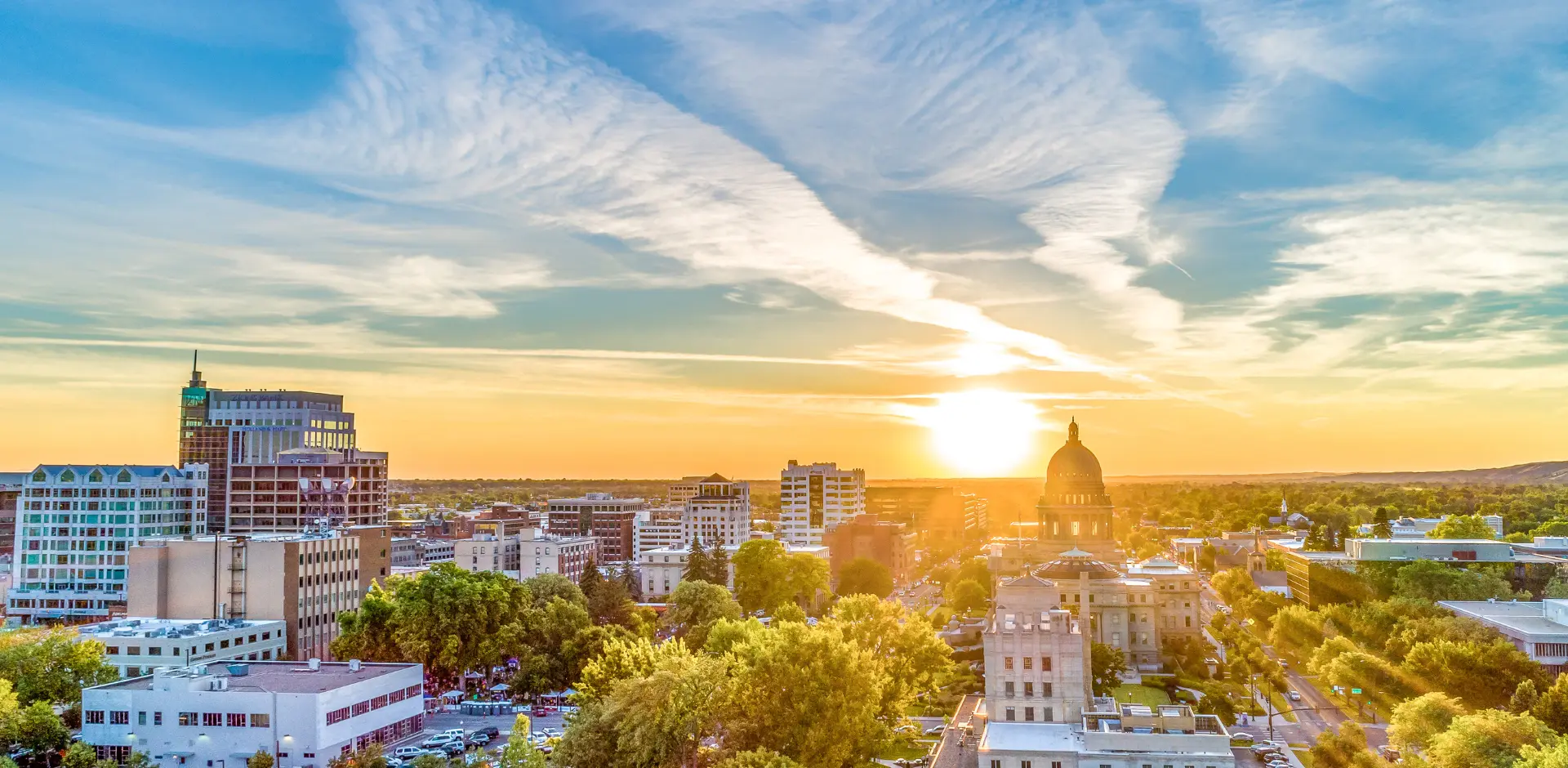
It may feel like months have passed since Idaho Governor Brad Little issued a March 25 statewide “stay at home” order to slow the spread of the coronavirus, or COVID-19, in our state. While we safely weather out the pandemic in relative seclusion, many potential buyers and sellers are wondering: what impact will this have on the Boise real estate market?
The short answer is: it’s too soon to tell, but we can look at history to get an idea of how stable the market will perform in the coming months and years. The important thing to keep in mind is that homes are still being listed, they’re still pending, and most importantly, they’re still selling – even in this new era of video-chat home tours and social distancing.
What the Treasure Valley Market Looks Like Right Now
Despite everything that is happening in the world, the Boise area real estate market has been strong, surprisingly so. Prices are hitting record highs, new listings are seeing multiple offers, there are waiting lists to view the most desirable properties, and homes are selling in half the time they were even a month ago.
At the same time, we have seen a roughly 10% decline in demand and new listings in the past month when compared to previous years. The two factors essentially canceling each other out with supply slightly lower than last April.
We are also seeing a number of homes come back on the market and canceled listings, which is to be expected when it is difficult to even get to closing.
2020 is going to look different than years past, but that isn’t necessarily a bad thing. A return to a more balanced market is long overdue. Our local market has been so hot – Boise home prices have risen nearly 80% in the past five years – that even a return to "normal" may seem scary to some.
Houses selling in days or weeks isn't typical. A balanced market is homes selling in 3 to 4 months.
Shifting to a more balanced market could help level the playing field for buyers. That said, don't expect to see substantial increases in housing prices this year but also don't expect to see a decline in prices for the foreseeable future.
 This twelve-year history of the Ada County housing market includes the impact of the pandemic in March.
This twelve-year history of the Ada County housing market includes the impact of the pandemic in March.
A Look at Future Trends and Shifting Prices
From quarantines to sheltering in place, It doesn’t take any special insight to know that there will be an impact on the local housing market. How much and for how long is the question.
The three most significant determiners of future home prices are supply, demand, and mortgages rates (affordability). Currently, supply is at 20-year lows. In Ada County alone, the population has grown by nearly 100,000 people in the last decade, creating a lot of new demand. At the same time, we are enjoying the lowest mortgage rates in history.
Examining past recessions, and viral events, can give us an idea of how the current coronavirus pandemic and economic slowdown could affect the Treasure Valley real estate market.
Sparked by a nationwide financial crisis that severely depressed home prices and sales until 2012, the Great Recession of 2007-09 and the subsequent decline in home prices is the outlier to what we typically see.
Looking at previous recessions over the last 40 years – those that took place in 2001, 1990-91, and 1981-82 – as well as how other viral episodes, like the 2013 SARS outbreak, gives us an idea of what to expect.
The short answer? Each of these events led to significant, short-term declines in the total number of transactions, averaging 30% to 40%. At the same time, from beginning to end, there were minimal changes in overall prices.
The biggest change thus far? Time frames have dramatically shifted. Buyers and sellers should be prepared to be patient. With everyone working from home and avoiding groups, you should expect mortgage applications, showings, and even closings to take twice as long as average.
 How previous recessions have impacted housing prices. ATTOM Data
How previous recessions have impacted housing prices. ATTOM Data
Showings and Viewing Properties in a Virtual World
As you would expect, traditional open houses right now are out of the question. At the same time, virtual open houses are quickly becoming the norm.
While days on market is still hovering around six, everything else will take longer than usual.
For viewings, instead of looking at six homes in person, buyers should plan on touring five or six homes by live video-chat, and two or three in person. There are benefits to this arrangement: buyers can tour homes without leaving home, which saves on time and stress. For sellers, this also means a lot less traffic marching through your property.
We Know Boise is no stranger to “digital." Our team has been providing virtual open houses, on-demand video tours, and paperless real estate transactions to our clients for years. We’re fortunate to be ahead of the curb.
As these avenues have become the norm in the past month, we've experienced a 400% increase in video walkthroughs, and our virtual reality tours have nearly doubled.
This abrupt shift in trends from in-person to nearly all-virtual transactions is spurring a real-estate technology renaissance. In the long run, it will propel the industry into providing more flexible services for all clients. While it has created some new challenges, it has never been easier for sellers to show and sell their property.
At the national level, there are plans to implement and normalize paperless closings via the SECURE Notarization Act. The formal "closing" on a home is the last hurdle to achieving a truly paperless real estate transaction.
We are predicting that one in five of our listings will sell this year without a single in-person showing.
 3D property tours like this one are rapidly gaining popularity.
3D property tours like this one are rapidly gaining popularity.
For Some, Getting a Loan Just Got Harder
As Warren Buffett famously said: “Only when the tide goes out do you discover who's been swimming naked.”
Even a minimal disruption in the real estate market will expose less than competent real estate agents, weak lenders, shaky builders, and overstretched developers—the good, the bad, and the ugly. Hiring an experienced, local real estate agent is more important than ever.
We’ve always recommended our clients choose a community-based lender, while avoiding national and online-only lenders.
Here’s the key difference: Local lenders actually keep the loans they make while national lenders sell the vast majority of their loans to third-party investors. Large banks that lack strong ties to local communities have historically been the quickest to turn off lending – or at least make it much harder to get for those that need it most.
In the current market, we’ve already seen national lenders and third-party investors pull back from making loans.
Jumbo loans, Idaho Housing and Finance Association loans (IHFA), Federal Housing Association loans (FHA), Veterans Affairs loans (VA), and loans to the self-employed will be the hardest to get in the coming months.
The good news: Interest rates are still very favorable and will likely continue to be for the foreseeable future. That said, we should expect a lot of volatility over the next few months as servicers (the lender on your mortgage statement) struggle with requirements from investors (the holder of the mortgage loan).
 Freddie Mac's Primary Mortgage Market Survey® shows rates near all-time lows. Freddie Mac
Freddie Mac's Primary Mortgage Market Survey® shows rates near all-time lows. Freddie Mac
Don’t Expect to See a Flood of Foreclosures Hit the Market
The national stimulus package allows for 180 days of forbearance (postponing loan payments), plus an additional 180-day extension. We expect to see roughly two million loans in forbearance within the next two months.
To prevent a repeat of the Great Recession, the federal government has ordered Fannie Mae and Freddie Mac to suspend foreclosures and evictions for at least 60 days. This is in addition to the year-long forbearance measures.
What this means is that we aren’t likely to see a substantial increase in foreclosed homes hitting the market in the next year – if at all.
New Construction Will Be Hit With Delays and Supply Disruptions
Like all real estate, new construction is considered an essential business in Idaho.
Where new construction is concerned, we are already seeing timelines for spec homes (new, move-in-ready homes) and custom "build jobs" increase. Build jobs that were estimated to take 4-6 months will end up being more in the range of 6-8 months due to social distancing, material constraints, and new limits on how many subcontractors can be on a job site at any given time.
Additionally, in the coming weeks and months, marginal builders and developers will struggle to get – or may lose – financing for custom build jobs and spec property developments.
Many new construction materials are imported from other countries that were struck by the current coronavirus pandemic, including many "finish" products like plumbing fixtures, hardwoods, and granite countertops. We expect to see supply disruptions start hitting our local construction market in the next couple of months.
 Treasure Valley population growth from the last 25 years. Data from the U.S. Census Bureau on Apr 3, 2020.
Treasure Valley population growth from the last 25 years. Data from the U.S. Census Bureau on Apr 3, 2020.
Relocation and Boise Population Growth
You won't see a lot of people moving across state lines in the short term, but like it or not, people relocating to the Treasure Valley has been a big driver of appreciation in recent years. Going forward, it will continue to have an outsized effect.
We will likely continue to see many new residents relocating to Idaho in the coming years. Crises and other large-scale events tend to put life into perspective for individuals and encourage the “life is short” mentality. People apply for retirement, decide to move closer to family, or simply want to “start fresh” in a smaller city with a lower cost of living.
Resist the Urge to Make Comparisons Between Housing Markets
We are all functioning in uncharted territory at the moment, and that can seem scary. The headlines will get (much) worse in the coming months before they get better.
Keep in mind, real estate markets are hyperlocal and wholly unique. That means you can’t compare large metropolitan areas like New York, Los Angeles, or even Seattle to what is happening in the Treasure Valley. Those markets have different population makeups, different job markets, and other vastly different factors attracting residents to their communities.







Leave A Comment